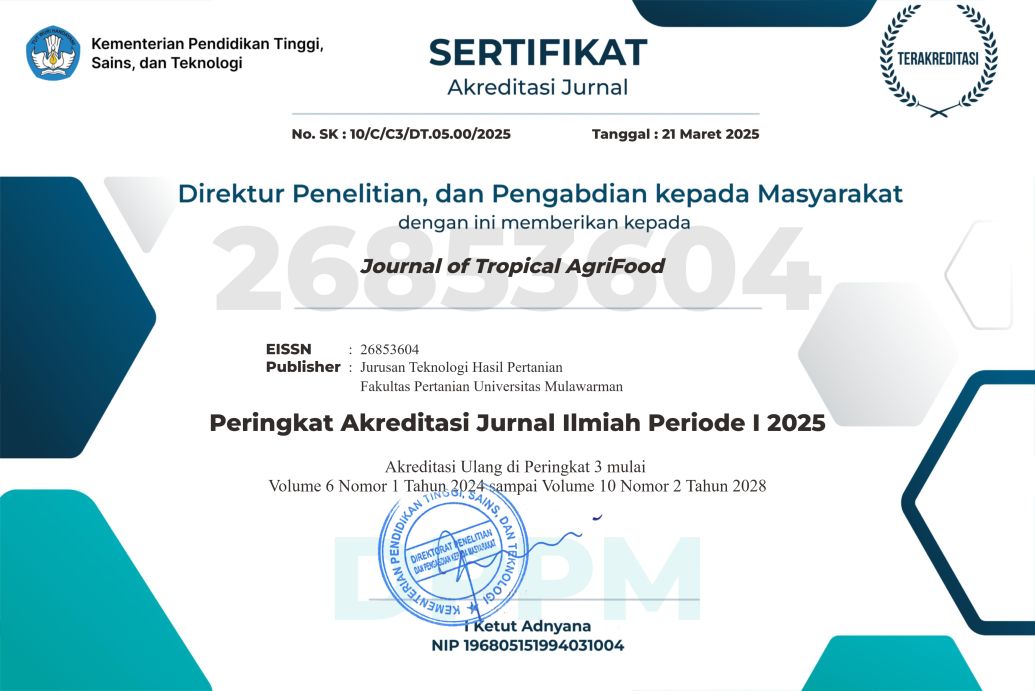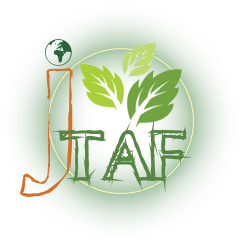Effect of fermented jicama extract with Lactobacillus plantarum B1765 as the starter culture on the product quality and total phenolic
Abstract
This research studied the effect of fermented jicama extract with Lactobacillus plantarum B1765 as a starter culture on the product qualities and Total Phenolic (TP). Fermentation was carried out for 0, 12, 24, and 36 hours at 37oC with 5% (v/v) of starter culture then determine the Total Lactic Acid Bacteria (LAB) were measured using the Total Plate Count (TPC) method, pH, and TTA were measured using a pH meter and acid-base titration, and TP was measured using the Folin-Ciocalteu method. These results showed that the length of fermentation affected increasing total LAB, TTA, TP, and decreasing pH. The best fermentation time in jicama extract was fermented is 24 hours with a total LAB of (9.7±0.31)x107 CFU/mL, pH of 4.21±0.22, TTA of 0.220±0.069%, and TP of 16.22±0.31 mg GAE/g. This value is following the criteria for fermented beverage products. Fermented jicama extract with L. plantarum B1765 potentially increases the TP.
Keywords
Full Text:
PDFReferences
Adebo, O.A., Njobeh, P.B., Adebiyi, J.A., Kayitesi, E., 2018. Co-influence of fermentation time and temperature on physicochemical properties, bioactive components, and microstructure of ting (a Southern African food) from whole grain sorghum. Food Biosci. 25, 118–127. https://doi.org/10.1016/j.fbio.2018.08.007
AOAC, 2005. Official Methods of Analysis of the Association of Analytical Chemists. Association of Official Analytical Chemist, Inc., Virginia, USA.
Aquino-Bolanos, E.N., Mercado-Silva, E., 2004. Effects of polyphenol oxidase and peroxidase activity, phenolics, and lignin content on the browning of cut Jicama. Postharvest Biol. Technol. 33, 275–283. https://doi.org/10.1016/j.postharvbio.2004.03.009
Cheng, K.C., Wu, J.Y., Lin, J.T., Liu, W.H., 2013. Enhancements of isoflavone aglycones, total phenolic content, and antioxidant activity of black soybean by solid-state fermentation with Rhizopus spp. Eur. Food Res. Technol. 236, 1107–1113. https://doi.org/10.1007/s00217-013-1936-7
Febriana, E., Wikandari, P.R., 2022. Effect of fermentation duration on tomato juice probiotic drink characteristics with starter culture of L. plantarum B1765. UNESA J. Chem. 11, 123–135.
Febricia, G.P., Nocianitri, K.A., Pratiwi, I.D.P.K., 2020. The effect of fermentation time on the characteristic of tamarillo juice (Solanum betaceum Cav.) probiotic drink with Lactobacillus sp. F213. J. Ilmu dan Teknol. Pangan 9, 170. https://doi.org/10.24843/itepa.2020.v09.i02.p07
Filannino, P., Bai, Y., Di Cagno, R., Gobbetti, M., Gänzle, M.G., 2015. Metabolism of phenolic compounds by Lactobacillus spp. during fermentation of cherry juice and broccoli puree. Food Microbiol. 46, 272–279. https://doi.org/10.1016/j.fm.2014.08.018
Huda, M., Wikandari, dan P.R., 2016. Determination of β-glukosidase activity in fermentation extract soya with starter culture Lactobacillus plantarum B1765. UNESA J. Chem. 5, 83–88.
Hunaefi, D., Gruda, N., Riedel, H., Akumo, D.N., Saw, N.M.M.T., Smetanska, I., 2013. Improvement of antioxidant activities in red cabbage sprouts by lactic acid bacterial fermentation. Food Biotechnol. 27, 279–302. https://doi.org/10.1080/08905436.2013.836709
Kamsina, 2014. The effect of juice concentration and kind of sugar on the quality of functional beverages from bengkuang (Pachyrhizus erosus). J. Litbang Ind. 4, 19. https://doi.org/10.24960/jli.v4i1.642.19-27
Kumar, N., Goel, N., 2019. Phenolic acids: Natural, versatile molecules with promising therapeutic applications. Biotechnol. Reports 24, 1–10. https://doi.org/10.1016/j.btre.2019.e00370
Landete, J.M., Hernández, T., Robredo, S., Dueñas, M., De Las Rivas, B., Estrella, I., Muñoz, R., 2015. Effect of soaking and fermentation on content of phenolic compounds of soybean (Glycine max cv. Merit) and mung beans (Vigna radiata L Wilczek). Int. J. Food Sci. Nutr. 66, 203–209. https://doi.org/10.3109/09637486.2014.986068
Leonard, W., Zhang, P., Ying, D., Adhikari, B., Fang, Z., 2021. Fermentation transforms the phenolic profiles and bioactivities of plant-based foods. Biotechnol. Adv. 49, 107763. https://doi.org/10.1016/j.biotechadv.2021.107763
Lodha, D., Das, S., Hati, S., 2021. Antioxidant Activity, total phenolic content and biotransformation of isoflavones during soy lactic-fermentations. J. Food Process. Preserv. 45, 1–9. https://doi.org/10.1111/jfpp.15583
Lukitaningsih, E., 2014. Bioactive compounds in bengkoang (Pachyrhizus erosus) as antiocidant and tyrosinase inhibiting agents. Indones. J. Pharm. 25, 68. https://doi.org/10.14499/indonesianjpharm25iss2pp68-75
Mailoa, M.N., Tapotubun, A.M., Matrutty, T.E.A.A., 2017. Analysis Total Plate Count (TPC) on fresh steak tuna applications edible coating caulerpa sp during stored at chilling temperature. IOP Conf. Ser. Earth Environ. Sci. 89. https://doi.org/10.1088/1755-1315/89/1/012014
Manongko, P.S., Sangi, M.S., Momuat, L.I., 2020. Phytochemical compound test and antioxidant activity of broken bone plants (Euphorbia tirucalli L.). J. MIPA 9, 64. https://doi.org/10.35799/jmuo.9.2.2020.28725
Montijo-Prieto, S. De, Razola-Díaz, M. del C., Barbieri, F., Tabanelli, G., Gardini, F., Jiménez-Valera, M., Ruiz-Bravo, A., Verardo, V., Gómez-Caravaca, A.M., 2023. Impact of lactic acid bacteria fermentation on phenolic compounds and antioxidant activity of avocado leaf extracts. Antioxidants 12, 1–17. https://doi.org/10.3390/antiox12020298
Myo, H., Nantarat, N., Khat-Udomkiri, N., 2021. Changes in bioactive compounds of coffee pulp through fermentation-based biotransformation using Lactobacillus plantarum TISTR 543 and its antioxidant activities. Fermentation 7. https://doi.org/10.3390/fermentation7040292
Nabila, L., Wikandari, P.R., 2018. Activity of inulinase enzyme from Lactobacillus plantarum B1765. UNESA J. Chem. 7, 44–47.
Nazarni, R., Purnama, D., Umar, S., Eni, H., 2016. The effect of fermentation on total phenolic, flavonoid and tannin content and its relation to antibacterial activity in Jaruk Tigarun (Crataeva nurvala, Buch HAM). Int. Food Res. J. 23, 309–315.
Nurjanah, N.F., Fauziyah, R.N., Rosmana, D., 2020. Yam bean velva dragon products based on red dragon fruit and bengkuang as an alternative of snack with inulin and antosianin fiber sources. J. Ris. Kesehat. Poltekkes Depkes Bandung 12, 149–169. https://doi.org/10.34011/juriskesbdg.v12i1.1761
Pau, S., Tan, L.C., Arriaga, S., Lens, P.N.L., 2022. Lactic acid fermentation of food waste at acidic conditions in a semicontinuous system: Effect of hrt and olr changes. Biomass Convers. Biorefinery. https://doi.org/10.1007/s13399-022-03201-w
Putri, C. perdana, Fevria, R., Chatri, M., Achyar, A., 2020. The Effect of sugar addition on fermentation time of sauerkraut from coles (Brassica oleracea L.). Symbiotic J. Biol. Educ. Sci. 1, 70–75. https://doi.org/10.32939/symbiotic.v1i2.7
Rafsanjani, E.R.M., Wikandari, P.R., 2017. The effect fermentation time of Lactobacillus plantarum B1765 lactic acid bacteria to the yacon root (Smallanthus sonchifolius) Pickle. UNESA J. Chem. 6, 76–80.
Rahmi, N., Khairiah, N., Rufida, R., Hidayati, S., Muis, A., 2020. Effect of fermentation on total phenolic, radical scavenging activity and antibacterial activity of waterlily (Nymphaea pubescens Willd.) seed flour extract. Biopropal Ind. 11, 9. https://doi.org/10.36974/jbi.v11i1.5553
Singhvi, M.S., Zinjarde, S.S., 2020. Production of pharmaceutically important genistein and daidzein from soybean flour extract by using β-glucosidase derived from Penicillium janthinellum NCIM 1171. Process Biochem. 97, 183–190. https://doi.org/10.1016/j.procbio.2020.07.014
Soetan, Olugboyega, K., Ojo, C., Olayele, K., 2018. Comparative in vitro antioxidant activities of six accessions of african yam beans (Sphenostylis stenocarpa L.). Ann. Food Sci. Technol. 19.
Sumardianto, P.H.R., Romadhon, A.D.A., Rianingsih, L., 2021. Phenol content and antioxidant activity in seaweed fermented with lactic acid bacteria. Food Res. 5, 7–13. https://doi.org/10.26656/fr.2017.5(S3).006
Suryono, I.A., Wikandari, P.R., 2019. Production profile of short chain fatty acids and lactic acid from yacon fermentation (Smallanthus sonchifollius) dengan bakteri kultur starter Lactobacillus plantarum B1765. J. Chem. 8, 92–97.
Svensson, L., Sekwati-Monang, B., Lutz, D.L., Schieber, R., Gänzle, M.G., 2010. Phenolic acids and flavonoids in nonfermented and fermented red sorghum (Sorghum bicolor (L.) Moench). J. Agric. Food Chem. 58, 9214–9220. https://doi.org/10.1021/jf101504v
Taylor, J.R., Duodu, K.G., 2015. Effects of processing sorghum and millets on their phenolic phytochemicals and the implications of this to the health-enhancing properties of sorghum and millet food and beverage products. J. Sci. Food Agric. 95, 225–237. https://doi.org/10.1002/jsfa.6713
Tsao, R., 2010. Chemistry and biochemistry of dietary polyphenols. Nutrients 2, 1231–1246. https://doi.org/10.3390/nu2121231
WHO, 2003. Codex Standard for Fermented Milks. World Health Organization and Food and Agriculture Organization, Washington.
Wijayanti, E.D., Setiawan, N.C.E., Christi, J.P., 2017. Effect of lactic acid fermentation on total phenolic content and antioxidant activity of fig fruit juice (Ficus carica), in: Health Science International Conference. pp. 282–289. https://doi.org/10.2991/hsic-17.2017.44
Yuksekdag, Z., Cinar Acar, B., Aslim, B., Tukenmez, U., 2018. β-Glucosidase activity and bioconversion of isoflavone glycosides to aglycones by potential probiotic bacteria. Int. J. Food Prop. 20, S2878–S2886. https://doi.org/10.1080/10942912.2017.1382506
Yuliani, Simbolon, J.H., Murdianto, W., 2017. Effect of acidity of extracting medium on yield and characteristics of pectine from “Mauli” banana (Musa sp) peel, in: Prosiding Seminar Nasional Balai Riset Dan Standarisasi Industri Samarinda. pp. 1–16.
Zhang, S., 2023. Recent Advances of Polyphenol Oxidases in Plants. Molecules 28, 2158. https://doi.org/10.3390/molecules28052158.
DOI: http://dx.doi.org/10.35941/jtaf.5.2.2023.12465.96-104
Refbacks
- There are currently no refbacks.

This work is licensed under a Creative Commons Attribution-ShareAlike 4.0 International License.
| ||
This journal is jointly published by Agricultural Products Technology Department, Mulawarman University, Indonesia and Indonesian Association of Food Technologist (PATPI) Kalimantan Timur. JTAF Today Visitors Copyright © 2025 Universitas Mulawarman Provide by e-Journal System Portal Center of Excelllence for Tropical Studies and Manage by Wisanggeni |








